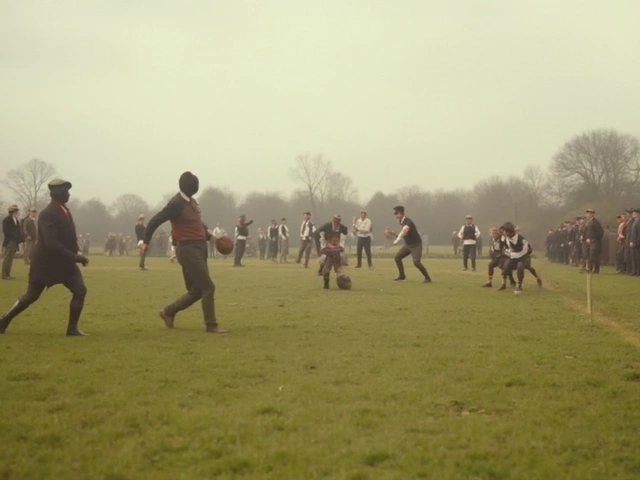
Tennis Tournaments June 10, 2025
How Good Is a 4.0 Tennis Player? Breaking Down the Reality
A 4.0 tennis player sits at a crossroads—no longer a beginner, miles past just rallying, but not quite the local club superstar either. The USTA 4.0 rating isn’t just some fancy number. It means you can keep up solid rallies, handle most second serves, and mix up your shots without thinking twice. Most 4.0s play regular matches, win some, lose some, but always make their opponents work for every point.
If you show up to a club tournament as a 4.0, you’re not going to see pushovers. Instead, expect to face players who can keep balls deep, read your patterns, and punish weak second serves. You’ll remember the first time you step on court and realize you can’t just hit safely down the middle—these players are waiting to pounce on anything short. Getting to this level takes real drills, not just casual hitting. Most 4.0s either train with a coach or at least show up for serious group sessions instead of mindless hitting for an hour.
- What Does 4.0 Mean, Exactly?
- Typical Strengths and Common Struggles
- Playing at Tournaments: What to Expect
- Moving Up or Down the Scale
- Tips for Cracking the 4.5 Ceiling
What Does 4.0 Mean, Exactly?
So, what’s behind that 4.0 label you see thrown around so much at local clubs and league rosters? In the USTA’s official rating system, a 4.0 player sits on the higher end of the intermediate scale. You’re not a beginner, you’re not a weekend warrior just batting the ball over—you actually look like you belong out there.
According to the USTA National Tennis Rating Program, 4.0 players have a solid understanding of tactics, can rally consistently on both forehand and backhand sides, and can serve with some variety. Your shot selection is smarter. You can pick apart a weaker opponent, and your mistakes usually come from going for winners or trying to add pace—not from basic errors.
Here’s what most 4.0s have in common:
- They can hit controlled topspin on both sides and handle pace.
- Serving confidence: They get a high percentage of first serves in and mix up placement.
- Net play feels comfortable, though not always polished.
- Strategy matters more—they try to set up points rather than just keep the ball in play.
- Fitness is a factor—they can handle longer points without wilting.
The jump from 3.5 to 4.0 tennis player is sometimes called the “big leap” at local clubs. You notice it when rallies get longer and slice or spin starts showing up more in matches. Mistakes come less from nerves and more from pushing your limits now.
To give you a sense of where a 4.0 sits in the tennis food chain, check out this table based on USTA self-rating categories:
| USTA Level | Skill Description | Common Opponents |
|---|---|---|
| 3.0 | Can keep short rallies going, inconsistent serve, basic shots only | Causal players, early league entries |
| 3.5 | Improved strokes, can hit with direction, short rallies | Recreational leagues, club matches |
| 4.0 | Reliable technique, good footwork, uses tactics, controls points | Serious club competitors, league teams, tournament matches |
| 4.5 | Stronger pace, finishes points, aggressive net play, smart tactics | Tournament regulars, strong league teams |
Bottom line, if you’re a 4.0, you can go toe-to-toe with legit competition. You’re probably entering tournaments or getting serious about league play. You know what you’re doing, and others at the club can see it, too.
Typical Strengths and Common Struggles
If you size up the average 4.0 tennis player, you’ll notice patterns in both strengths and weak spots. You rarely see total beginners at this level. Instead, you find people who have consistent groundstrokes, can volley without panicking, and hold their serve a decent amount of the time. These players know how to set up points rather than just react, and they understand basic tactics—like mixing up pace or using angles.
- Serve: Most 4.0s have a first serve with decent pace and placement. Second serves come in reliably but aren’t always dangerous.
- Rallies: Regular 10–15 shot rallies are common. Players keep the ball deep and force mistakes instead of trying for too many winners.
- Net Play: Volleys work fine when they move forward on purpose, usually off a short ball, but reflex volleys can still get shaky under pressure.
- Movement: They can chase down most mid-court shots, but sprinting cross-court or recovering from tough positions often separates the best 4.0s from those barely there.
But it’s not all smooth sailing. The biggest obstacles at 4.0? Finishing points and staying consistent mentally. When rallies get long, players try to end points too early, leading to avoidable errors. For every crisp backhand winner, there might be a frustrated netted forehand on the next point because of impatience. On top of that, handling junk balls—heavy spin, moonballs, or soft slices—still wipes out plenty of players who haven’t quite seen it all.
Another real struggle: translating practice court game to match play. Some data says over 40% of USTA 4.0 match losses happen after a player leads by a set, showing how nerves and focus can go sideways under pressure.
| Strengths | Common Struggles |
|---|---|
| Solid groundstrokes Can sustain rallies Basic net play Consistent second serves Understands tactics | Closing points Mental consistency under stress Reacting to spin or junk balls Movement on defense Making adjustments mid-match |
Want to move up? Start here: Track your unforced errors, especially on easy balls. Notice if you lose focus when ahead. Play more matches that actually count in league play, not just practice sets. Anything that hammers those trouble spots will do way more than just drilling pretty strokes over and over.

Playing at Tournaments: What to Expect
Walking into a tournament as a 4.0 tennis player can be a reality check, even if you feel confident at your local courts. Most club and USTA tournaments in the U.S. draw a variety of players, but once you get to the 4.0 division, everyone takes things seriously. The matches aren’t just friendly rallies—they’re battles where strategy, nerves, and fitness all matter.
You’ll face opponents who know how to target your weaknesses. If your backhand is shaky or you avoid the net, expect someone to figure that out by the third game. Nobody just lobs the ball back to keep it in play—people will throw topspin, slices, and angles at you to disrupt your rhythm. Don’t be surprised if points last 10–15 strokes, especially on slow courts.
At this level, line calls can get spicy. Always call the score out loud and be clear about boundaries from the start. Most tournaments follow strict USTA rules, and you’ll be responsible for knowing them. Wrong-foot a serve or forget to switch sides at the right time, and someone will call you on it. Matches are usually played in the best-of-three set format, and tiebreakers are pretty common—so get comfy with sudden-death pressure.
- Tournament 4.0 draws often have 16 to 32 players.
- You’ll play up to three full matches in a single weekend at larger events.
- Recovery between matches (sometimes only 60–90 minutes) is super important—stretch, hydrate, and eat something easy on your stomach.
- Warm up is usually limited to 10 minutes. Don’t waste it just rallying; use it to test your strokes and check the court conditions.
Here’s what you might see at a typical adult USTA event:
| # of 4.0 Players | Avg Age | Matches per Day | Chance of 3-Set Matches |
|---|---|---|---|
| 24 | 37 | 2 | 40% |
Don’t go in expecting an easy run. Even the best players in the 4.0 tennis player bracket have off days, but the competition pushes everyone to play smarter. Watch for those little habits—players tap their racquet when nervous, or bounce their serves extra times. Learning these tells can give you an edge.
Best advice? Play your game, but have a backup plan. Sometimes it’s not about hitting winners, but keeping the ball deep and waiting for the right moment. The mental side of tournament tennis is what most newcomers overlook, and it’s the secret sauce for scoring those tough wins.
Moving Up or Down the Scale
If you’ve landed at the 4.0 tennis player rating, you probably want to know what it takes to climb up—or what might drop you back to 3.5. USTA ratings can change each year depending on your tournament results and league matches. So, just because you’re a 4.0 now doesn’t mean you’re stuck there for life. On the flip side, losing a bunch of matches against 4.0s or struggling with basic consistency can bump you down after a season.
To move up to 4.5, you need more than just consistency. This usually means:
- You can handle fast-paced rallies without breaking down.
- You’re starting to use strategy, like recognizing opponents’ weaknesses.
- You can finish points at the net and create pressure rather than just react.
- You defend well when pushed out wide and recover to neutral quickly.
Winning a majority of your matches in USTA tournaments or leagues against fellow 4.0s also matters a lot. The USTA actually uses a computer algorithm—sometimes referred to as the "Dynamic Rating" system—that updates your rating based on match outcomes and the strength of your opponents. Basically, if you’re crushing other 4.0s, you’ll get bumped up in the next ratings cycle.
On the other hand, some players hang around 4.0 for years because they don’t add new skills. Maybe they rely on safe shots or avoid coming to the net entirely. Plateaus happen if your game gets predictable or you don’t work on obvious weaknesses. A coach at my club puts it this way:
“At 4.0, players need to embrace uncomfortable change if they want to get better. The jump to 4.5 is all about adding weapons, not just avoiding errors.”
If you notice your rating dropping, don’t panic. Take it as a sign to get real with your training. Ask stronger players what holes they see in your game. Video your matches. Set one or two small goals per week, like improving your second serve or being brave at the net, and track your results. Progress isn’t always smooth, but staying active in tournaments or leagues keeps you honest about where you stand.

Tips for Cracking the 4.5 Ceiling
So you’re a solid 4.0, but eyeing that 4.5 badge? The jump feels brutal for a reason. Most 4.0s hit a wall because their game is good—but just a little too predictable. Here’s what will actually help you break free from that plateau.
First, look at your shot variety. At 4.5, players punish patterns they can spot. If you always loop a forehand crosscourt or slice your backhand on defense, experienced 4.5s catch on in minutes. Make sure you can add topspin, slice low, and drive flat balls depending on the situation.
Your serve is the next big step. At 4.0, a safe serve can sneak by. At 4.5? Weak second serves get crushed. Work on placing your first serve wide, down the middle, and at the body, with both slice and topspin options. You’ll make life much easier for yourself.
- 4.0 tennis player looking to jump levels? Develop a strong serve-plus-one routine so you start points from a winning position.
- Use more approach shots and net play. Most 4.0s camp at the baseline—if you’re comfortable finishing points at net, you stand out.
- Hit with intent. Don’t just hit it back—pick a target each time. Move your opponent around and break up their rhythm.
Lastly, focus on the mental side. Most 4.0s get tense, especially in tight matches. Learn to breathe, reset on errors, and play the next point—not the score. Frequent tournament play helps, because you’ll get used to match pressure and learn not to fall apart when it matters.
If you take lessons, ask your coach for point-based drills, not just stroke work. The more you play under pressure, the more natural 4.5 tennis will feel. Cutting out unforced errors and building just one more weapon—like a sharper return or a surprise drop shot—often makes the real difference.




